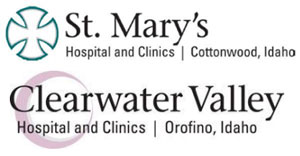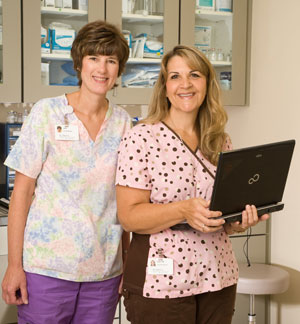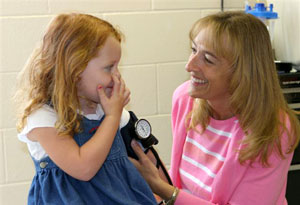Medical Home Plus
- Need: To help reduce diabetes, depression, and stroke risk in rural residents.
- Intervention: A collaborative care model was implemented in the Idaho counties of Clearwater, Idaho, and Lewis.
- Results: Increased number of patients with controlled blood sugar, controlled blood pressure, and higher depression screening rates.
Description
 St.
Mary's Hospital and Clearwater Valley Hospital and
Clinics serve approximately 28,000 people in 3 counties
of North-Central Idaho, Clearwater, Idaho, and Lewis,
including parts of the Nez Perce Indian Reservation.
St.
Mary's Hospital and Clearwater Valley Hospital and
Clinics serve approximately 28,000 people in 3 counties
of North-Central Idaho, Clearwater, Idaho, and Lewis,
including parts of the Nez Perce Indian Reservation.
The Medical Home Plus project was created in partnership with 9 consortium members to connect frontier residents with primary care providers, active nurse case managers, and integrated community referral coordinators.
The project utilizes a collaborative care model and a medical home model. Nurse case managers worked as team members in a patient-centered medical home to help set patient health goals, discuss barriers, identify solutions along with monitoring patients' progress. They also encouraged patients to get needed diagnostic testing. The case managers additionally discover issues with medication management and help create solutions. Other activities included transportation assistance for appointments, and assisting with issues stemming from social isolation and poverty.
The model further integrated case management with community referral coordinators, 1 hired at each hospital. Coordinators maintained an online database of community resources such as mental health resources, substance abuse counselors, and weight loss programs. Additionally, case managers sent service requests to the referral coordinators, who then helped track specialty referrals, appointments, and results. Medical Home Plus received support from a 2012-2015 Federal Office of Rural Health Policy Rural Health Care Services Outreach grant. Grant funds were used to hire nurse case managers and community referral coordinators at 3 primary care clinics managed by 2 Critical Access Hospitals.

Case managers were assisted by community referral
coordinators, who were hired at each of the 2 Critical
Access Hospitals. Coordinators maintained an online
database of community resources such as mental health
resources, substance abuse counselors, and weight loss
programs. Case managers sent service requests to the
referral coordinators, who then then helped track
specialist referrals, appointments, and results.
Medical Home Plus received support from a 2012-2015 Federal Office of Rural Health Policy Rural Health Care Services Outreach grant. Grant funds were used to hire nurse case managers and community referral coordinators at 3 primary care clinics managed by 2 Critical Access Hospitals.
Services offered
- Shared facility discharge instructions
- Free electronic community resource directory available for consortium partners and the community
- Community resource referral tracking in electronic medical records
- County-wide human needs council attendance by case managers
Results
During the grant cycle:
- 3 nurse case managers provided services to 255 patients
- Almost 6,000 patients have received more than 11,000 referrals during the project, with 351 being community referrals
- Of patients receiving case management services, 65% had controlled blood sugar, 79% had controlled blood pressure, and 78% had been screened for depression
- Mental health referrals for patients with active suicide ideations after identification by nurse case managers, patients not previously identified by family or clinical care teams
- Decreased readmission rates by about 4% at St. Mary's hospital; for July 2012 to February 2015, Clearwater Valley Hospital readmission rates decreased by about 1%
- 5 processes have been adopted for shared communication of patient information
Challenges
Challenges that this program has faced include:
- Reaching the target number of patients for case management services: target was too high for the high-risk population Medical Home Plus was trying to serve
- Finding efficient performance review indicators
- Focus population changes due to payer
priorities
Replication
In order to create a similar program, it is important to:

- Listen to the doctors' needs and frustrations
- Market and communicate services differently to different audiences
- Group participants based on the frequency with which they need to be contacted, then color-code files based on that
- Break down aggregate data by site to identify differences in implementation patterns that help see best practices
- Remind hospital staff of appropriate ways to admit and schedule new patients
- Create open communication between mental health providers and hospital/clinic facilities
Contact Information
Shari Kuther, RN, Director of Population HealthSt. Mary's Clearwater Valley Hospital and Clinics
208.962.2473
shari.kuther@smh-cvhc.org
Topics
Cardiovascular disease
Critical Access Hospitals
Diabetes
Frontier and remote areas
Medical homes
Mental health
Mental health conditions
Wellness, health promotion, and disease prevention
States served
Idaho
Date added
September 14, 2015
Date updated or reviewed
February 27, 2020
Suggested citation: Rural Health Information Hub, 2020. Medical Home Plus [online]. Rural Health Information Hub. Available at: https://www.ruralhealthinfo.org/project-examples/821 [Accessed 19 April 2024]
Please contact the models and innovations contact directly for the most complete and current information about this program. Summaries of models and innovations are provided by RHIhub for your convenience. The programs described are not endorsed by RHIhub or by the Federal Office of Rural Health Policy. Each rural community should consider whether a particular project or approach is a good match for their community’s needs and capacity. While it is sometimes possible to adapt program components to match your resources, keep in mind that changes to the program design may impact results.
